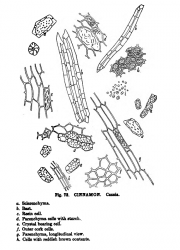Cinnamomum aromaticum (bark)
(→wikipedia and structure) |
|||
| Line 1: | Line 1: | ||
| + | =Introduction= | ||
| + | |||
| + | ''Introduction from Wikipedia, the free encyclopedia (http://en.wikipedia.org/wiki/Cinnamomum_aromaticum, retrieved 02/22/2012).'' | ||
| + | |||
| + | ''Cinnamomum aromaticum'', called cassia or Chinese cinnamon, is an evergreen tree native to southern China, Bangladesh, Uganda, India, and Vietnam. Like its close relative ''Cinnamomum verum'', also known as "Ceylon cinnamon", it is used primarily for its aromatic bark, which is used as a spice. In the United States of America, cassia is often sold under the culinary name of "cinnamon". The buds are also used as a spice, especially in India, and were once used by the ancient Romans. | ||
| + | |||
| + | The tree grows to 10–15 m tall, with greyish bark and hard elongated leaves that are 10–15 cm long and have a decidedly reddish colour when young. | ||
| + | |||
| + | ''The quoted text in this section was licensed for use under the Creative Commons ShareAlike License, version 3.0: http://creativecommons.org/licenses/by-sa/3.0/'' | ||
| + | |||
| + | =Macroscopic Entries= | ||
| + | =Microscopic Entries= | ||
{{Microscopy | source=Schneider, A. (1921) The Microanalysis of Powdered Vegetable Drugs, 2nd ed. | {{Microscopy | source=Schneider, A. (1921) The Microanalysis of Powdered Vegetable Drugs, 2nd ed. | ||
| mainimage=Microanalysis_powdered_vegetable_google_ver_cinnamon_cassia.png | | mainimage=Microanalysis_powdered_vegetable_google_ver_cinnamon_cassia.png | ||
| Line 9: | Line 21: | ||
| adulterants=Cassia cinnamon in particular is likely to be adulterated with inferior cassia barks, clove bark, flour, inert vegetable substances. The quality of cassia cinnamon is proportionate to the number of bast cells present. The very inferior grades show few bast cells, which indicates that the outer older bark tissue predominates. Cassia cinnamons could readily be graded according to the bast cell count. The organoleptic tests, especially taste and odor, are also valuable guides to quality. | | adulterants=Cassia cinnamon in particular is likely to be adulterated with inferior cassia barks, clove bark, flour, inert vegetable substances. The quality of cassia cinnamon is proportionate to the number of bast cells present. The very inferior grades show few bast cells, which indicates that the outer older bark tissue predominates. Cassia cinnamons could readily be graded according to the bast cell count. The organoleptic tests, especially taste and odor, are also valuable guides to quality. | ||
| }} | | }} | ||
| + | =HPTLC Entries= | ||
| + | |||
| + | =Other Points of Interest= | ||
Revision as of 15:51, 23 February 2012
Contents |
Introduction
Introduction from Wikipedia, the free encyclopedia (http://en.wikipedia.org/wiki/Cinnamomum_aromaticum, retrieved 02/22/2012).
Cinnamomum aromaticum, called cassia or Chinese cinnamon, is an evergreen tree native to southern China, Bangladesh, Uganda, India, and Vietnam. Like its close relative Cinnamomum verum, also known as "Ceylon cinnamon", it is used primarily for its aromatic bark, which is used as a spice. In the United States of America, cassia is often sold under the culinary name of "cinnamon". The buds are also used as a spice, especially in India, and were once used by the ancient Romans.
The tree grows to 10–15 m tall, with greyish bark and hard elongated leaves that are 10–15 cm long and have a decidedly reddish colour when young.
The quoted text in this section was licensed for use under the Creative Commons ShareAlike License, version 3.0: http://creativecommons.org/licenses/by-sa/3.0/
Macroscopic Entries
Microscopic Entries
|
HPTLC Entries
Other Points of Interest
Cite error: <ref> tags exist, but no <references/> tag was found
